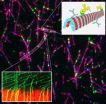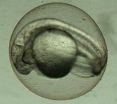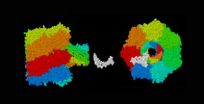(Press-News.org) JUPITER, FL – Scientists from the Florida campus of The Scripps Research Institute (TSRI) have shown that a single protein plays an oversized role in intellectual and behavioral development. The scientists found that mutations in a single gene, which is known to cause intellectual disability and increase the risk of developing autism spectrum disorder, severely disrupts the organization of developing brain circuits during early childhood. This study helps explain how genetic mutations can cause profound cognitive and behavioral problems.
The study was published in the November 9, 2012, issue of the journal Cell.
The genetic mutations that cause developmental disorders, such as intellectual disability and autism spectrum disorder, commonly affect synapses, the junctions between two nerve cells that are part of the brain's complex electro-chemical signaling system. A substantial percentage of children with severe intellectual and behavioral impairments are believed to harbor single mutations in critical neurodevelopmental genes. Until this study, however, it was unclear precisely how pathogenic genetic mutations and synapse function were related to the failure to develop normal intellect.
"In this study, we did something no one else had done before," said Gavin Rumbaugh, a TSRI associate professor who led the new research. "Using an animal model, we looked at a mutation known to cause intellectual disability and showed for the first time a causative link between abnormal synapse maturation during brain development and life-long cognitive disruptions commonly seen in adults with a neurodevelopmental disorder."
Losing Balance
The study focused on a critical synaptic protein known as SynGAP1. Mutations in the gene that encodes this protein cause disabilities in an estimated one million people worldwide, according to the paper.
"There are a few genes that can't be altered without affecting normal cognitive abilities," Rumbaugh said. "SynGAP1 is one of the most important genes in cognition—so far, every time a mutation that disrupts the function of SynGAP1 has been found, that individual's brain simply could not develop correctly. It regulates the development of synaptic function like no other gene I've seen."
Using animal models that were missing just one copy of SynGAP1, as seen in some patients with intellectual disability, the scientists found that certain synapses develop prematurely in the period shortly after birth. This dramatically enhances what is known as "excitability"—how often brain cells fire—in the developing hippocampus, a part of the brain critical for memory. The balance between excitability and inhibition is especially critical during early developmental periods, when neural connections that ultimately give rise to normal cognitive and behavioral functions are forming.
"You might think this accelerated development of brain circuits would make you smarter," Rumbaugh said. "But the increased excitability actually disorganizes brain development. We think that early maturation of these excitatory synapses disrupts the timing of later developmental milestones. It rains down chaos on this complex process, preventing normal intellectual and behavioral development."
A Critical Window
Interestingly, inducing these mutations after the critical development period was complete had virtually no impact on normal synapse function and repairing these pathogenic mutations in adulthood did not improve behavior or cognition.
"A key finding is we were able to remove the mutation and restore SynGAP protein levels in adult mice with obvious cognitive and behavioral problems, but this intervention did not benefit the animals," Rumbaugh said.
These results imply that very early intervention is essential in neurodevelopmental disorders, particularly for cognitive problems. The team is now aggressively searching for the optimal period during development in which repairing these mutations is most beneficial.
Rumbaugh speculates that successfully defining these treatment windows, combined with the fast-approaching ability to identify potential pathogenic mutations in utero, will provide a possible path toward eradicating this type of intellectual disability and lowering the risks for autism. "We believe a cure is possible," he said. "It is likely that there are many other single mutations out there that cause distinct forms of these spectrum disorders. Our strategy could be applied to these disorders as well."
INFORMATION:
The first author of the study, "Pathogenic SYNGAP1 Mutations Impair Cognitive Development by Disrupting the Maturation of Dendritic Spine Synapses," is James Clement of TSRI. Other authors include Massimiliano Aceti, Thomas Creson, Emin D Ozkan, Brooke Miller, and Courtney A. Miller of TSRI; Yulin Shi and Xiangmin Xu of The University of California, Irvine; Nicholas Reis and Antoine Almonte of The University of Alabama at Birmingham; and Brian Wiltgen of The University of Virginia.
The study was funded by the National Institute for Neurological Disorders and Stroke (R01NS064079), the Eunice Kennedy Shriver National Institute for Child Health and Human Development (R03HD060672), the National Alliance for Research on Schizophrenia and Depression, and the National Institute for Drug Abuse (DA023700-04S1).
About The Scripps Research Institute
The Scripps Research Institute (TSRI) is one of the world's largest independent, not-for-profit organizations focusing on research in the biomedical sciences. Over the past decades, TSRI has developed a lengthy track record of major contributions to science and health, including laying the foundation for new treatments for cancer, rheumatoid arthritis, hemophilia, and other diseases. The institute employs about 3,000 people on its campuses in La Jolla, CA, and Jupiter, FL, where its renowned scientists—including three Nobel laureates—work toward their next discoveries. The institute's graduate program, which awards Ph.D. degrees in biology and chemistry, ranks among the top ten of its kind in the nation. For more information, see www.scripps.edu.
Scientists uncover secrets of how intellect and behavior emerge during childhood
2012-11-08
ELSE PRESS RELEASES FROM THIS DATE:
Meet Xenoceratops: Canada's newest horned dinosaur
2012-11-08
Ottawa, Canada (November 8, 2012) – Scientists have named a new species of horned dinosaur (ceratopsian) from Alberta, Canada. Xenoceratops foremostensis (Zee-NO-Sare-ah-tops) was identified from fossils originally collected in 1958. Approximately 20 feet long and weighing more than 2 tons, the newly identified plant-eating dinosaur represents the oldest known large-bodied horned dinosaur from Canada. Research describing the new species is published in the October 2012 issue of the Canadian Journal of Earth Sciences.
"Starting 80 million years ago, the large-bodied ...
UMass Amherst cell biologists identify new protein key to asymmetric cell division
2012-11-08
AMHERST, Mass. – Recently biologists at the University of Massachusetts Amherst led by Wei-lih Lee have identified a new molecular player in asymmetric cell division, a regulatory protein named She1 whose role in chromosome- and spindle positioning wasn't known before. Asymmetric cell division is important in the self-renewal of stem cells and because it ensures that daughter cells have different fates and functions.
When a fertilized egg develops in a fruit fly or a human being, the number of asymmetric cell divisions must be precisely balanced by symmetric cell divisions, ...
Scientists reveal key protein interactions involved in neurodegenerative disease
2012-11-08
JUPITER, FL, November 8, 2012 – Scientists from the Florida campus of The Scripps Research Institute (TSRI) have defined the molecular structure of an enzyme as it interacts with several proteins involved in outcomes that can influence neurodegenerative disease and insulin resistance. The enzymes in question, which play a critical role in nerve cell (neuron) survival, are among the most prized targets for drugs to treat brain disorders such as Parkinson's disease, Alzheimer's disease and amyotrophic lateral sclerosis (ALS).
The study was published online ahead of print ...
Unique spinal nerve cell activity discovery announced by University of Leicester biologists
2012-11-08
Scientists from the University of Leicester have hit upon unique forms of spinal nerve activity that shape output of nerve cell networks controlling motor behaviours.
The breakthrough in the Department of Biology at the University of Leicester is announced today (5pm GMT on Thursday Nov 8) in the journal Current Biology. The three- year study was funded by the Biotechnology and Biological Sciences Research Council (BBSRC).
Although the neural basis of motor control has been studied for over a century, the processes controlling maturation of locomotor behaviours – like ...
Rethinking body mass index for assessing cancer risk
2012-11-08
November 8, 2012 — (Bronx, NY) — A study by researchers at Albert Einstein College of Medicine of Yeshiva University suggests that body mass index (BMI)—the most commonly used weight-for-height formula for estimating fatness—may not be the best measure for estimating disease risk, and particularly the risk of certain types of cancer. The study was published today in the online edition of the American Journal of Epidemiology.
BMI is calculated by dividing a person's weight (in kilograms) by his or her height in meters squared, or W/H2. Most of the early studies that ...
Cells from skin create model of blinding eye disease
2012-11-08
MADISON — For the first time, Wisconsin researchers have taken skin from patients and, using induced pluripotent stem cell (iPSC) technology, turned them into a laboratory model for an inherited type of macular degeneration.
Dr. David Gamm, director of the UW's McPherson Eye Research Institute, said that while Best disease is relatively rare, having a patient-specific model of the eye disease, which destroys the macula of the retina, could lead to a greater understanding of more common eye disorders such as age-related macular degeneration.
"This model gives us a chance ...
Dream symbols could help in psychotherapy
2012-11-08
Dream images could provide insights into people's mental health problems and may help with their treatment, according to a psychology researcher from the University of Adelaide.
Dr Lance Storm, a Visiting Research Fellow with the University of Adelaide's School of Psychology, has been studying dream symbols (or "archetypes") and their meanings, as described by the famous psychologist and psychiatrist, Carl Jung.
In the early 1900s, Jung proposed that these archetypes were ancient images stemming from humans' collective unconscious. He believed that dream symbols carried ...
Injection is the best method for cutting ammonia emissions from slurry spreading on lands
2012-11-08
In order to contribute to the development of the primary sector and environmental care, the Basque Institute of Agricultural Research and Development, NEIKER-Tecnalia, has analysed various ways of spreading slurry on arable land to determine the most appropriate way of cutting the amount of ammonia that is released into the atmosphere.
The three methods studied were: the traditional splash plate or fan method, hanging pipes, or injection. The last one turned out to be the most environmentally friendly in terms of ammonia emissions (NH3), as it achieves a 93% cut in NH3 ...
Carbon dioxide – our salvation from a future ice age?
2012-11-08
Mankind's emissions of fossil carbon and the resulting increase in temperature could prove to be our salvation from the next ice age. According to new research from the University of Gothenburg, Sweden, the current increase in the extent of peatland is having the opposite effect.
"We are probably entering a new ice age right now. However, we're not noticing it due to the effects of carbon dioxide", says researcher Professor Lars Franzén.
Looking back over the past three million years, the earth has experienced at least 30 periods of ice age, known as ice age pulses. ...
Pull with caution
2012-11-08
As nanotechnology progresses, it becomes increasingly important to know in detail the dynamics of the nanoworld (the world at the scale of a millionth of a millimeter). What happens, for example, when we try to drive a polyelectrolyte (a long chain of electrically charged molecules, such as DNA) through a nanopore if knots cause the translocation process to jam? It's not a pointless question, because now a new DNA sequencing method to electrochemically analyze every single strand by driving it through a nanopore, is being developed. Since those strands tend to tangle up ...





